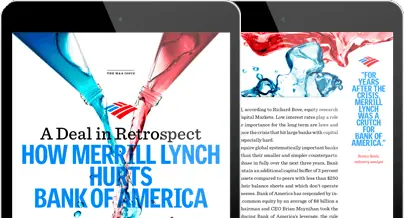
A Deal in Retrospect
For more than six decades after the Great Depression, the nation’s biggest banks pined to recombine investment and commercial banking operations under one roof. They got their wish in 1999 when Congress overturned the last vestiges of the Glass-Steagall Act, but these same banks are in many ways now paying a steep price for that decision.
“It’s safe to say that nobody is out there trying to start a universal bank today,” says Frederick Cannon, the global director of research at Keefe, Bruyette & Woods, an investment bank specializing in the financial services sector. To understand how things changed so much in less than two decades, one needn’t look beyond Bank of America’s 2008 acquisition of Merrill Lynch. The once promising combination now subjects Bank of America to an austere assortment of post-crisis regulations that impair its profitability.
Initial Impressions
The marriage of Bank of America’s coast-to-coast branch network to Merrill Lynch’s thundering herd of financial advisers initially seemed like a match made in heaven. “Acquiring one of the premier wealth management, capital markets, and advisory companies is a great opportunity for our shareholders,” Bank of America’s former Chairman and Chief Executive Officer Kenneth Lewis said at the time. “Together, our companies are more valuable because of the synergies in our businesses.”
Despite their complementary business lines, however, feelings toward the deal proceeded to evolve. It seemed in its immediate wake like Merrill Lynch got the better end of the bargain, following its $15 billion loss in the fourth quarter of that year. But as tens of billions of dollars’ worth of losses later mounted in Bank of America’s credit card and home lending divisions, Merrill Lynch began to look like Bank of America’s savior. “For years after the crisis, Merrill Lynch was a crutch for Bank of America,” says Nancy Bush, a longtime industry analyst.
Flash forward to today and sentiment has changed yet again. In each of the past eight years, Bank of America has failed to earn the 12 percent on its equity that’s needed to create shareholder value-its cost of capital, according to Richard Bove, equity research analyst at Rafferty Capital Markets. Low interest rates play a role in this, but of greater importance for the long term are laws and regulations passed since the crisis that hit large banks with capital markets businesses especially hard.
Regulators now require global systematically important banks to hold more capital than their smaller and simpler counterparts. Once the new rules phase in fully over the next three years, Bank of America must maintain an additional capital buffer of 3 percent of its risk-weighted assets compared to peers with less than $250 billion in assets on their balance sheets and which don’t operate capital markets businesses. Bank of America has responded by increasing its tangible common equity by an average of $8 billion a year since current Chairman and CEO Brian Moynihan took the reins in 2010. By reducing Bank of America’s leverage, the rule translates directly into a lower return on equity. Bank of America had the lowest return on average equity, at 6.19 percent, of all the big banks as published in Bank Director’s 2016 Bank Performance Scorecard in the third quarter issue, based on the 2015 fiscal year.
Is It Time to Break up the Bank?
This handicap may be on the verge of getting worse. A pair of Federal Reserve governors intimated in June that the central bank may require the eight U.S.-based global systematically important banks to hold even more capital in future stress tests. “I have not reached any conclusion that a particular bank needs to be broken up or anything like that,” said Jerome Powell in The Wall Street Journal, echoing his colleague Daniel Tarullo. The intent is instead to “raise capital requirements to the point at which it becomes a question that banks have to ask themselves.”
Moynihan has already reached this point. “We look at it constantly,” he said at this year’s Bernstein Strategic Decisions Conference in response to an analyst’s question about whether executives at the bank debate its business model and have considered spinning off parts of the company. The 56-year-old CEO nevertheless dismissed the idea of divesting additional product lines, noting that Bank of America has already sold 60 businesses and shrunk its pro forma balance sheet by as much as $600 billion.
“Because it’s so hard to build a universal bank today, we think our business model gives us a competitive advantage with clients who want access to a full range of banking products,” says Jerry Dubrowski, senior vice president of corporate communications at Bank of America.
Liquidity Rule Emerges
Yet, in addition to higher capital requirements, universal banks must also now dedicate a larger share of their assets to low-yielding, high-quality liquid assets-things like cash and government securities. This reflects the fact that banks tend to fail from runs on their liquidity and not from a lack of capital. This was the case in 1907 with the Knickerbocker Trust Company. It was the case in the 1984 collapse of Continental Illinois, the first bank to be branded too big to fail. And it was the case at Bear Stearns and Washington Mutual in 2008.
Regulators designed the liquidity coverage ratio to address this issue. The new measure is analogous to the annual stress tests, but rather than focusing on how much capital a global systematically important bank could lose during a period of severe economic turmoil, it measures the impact on liquidity. It does so by forecasting how much cash customers might withdraw from a bank over a 30-day period of stress, and then requiring the bank to hold that amount of high-quality liquid assets.
The liquidity coverage ratio hits Bank of America hard because of its capital markets activities, which trace their roots primarily to Merrill Lynch. The rule presupposes that a universal bank will hemorrhage more cash in future crises because of its prime brokerage, trading units, and exposure to derivatives when compared to a bank that focuses on retail activities. For instance, while 3 to 10 percent of a bank’s retail deposits are presumed by the rule to flee under stress, this increases to as much as 100 percent when it comes to cash held by customers in a bank’s prime brokerage.
You can get a sense for the impact of this on Bank of America’s profitability by comparing its balance sheet to that of Wells Fargo, which relies more heavily on retail deposits and has less exposure to the capital markets. Largely because Wells Fargo allocates 51 percent of its assets to loans relative to Bank of America’s 41 percent, Wells Fargo’s annualized yield on earning assets exceeded Bank of America’s by 63 basis points in the first quarter. The difference equates to $11.6 billion in annual pre-tax interest income based on Bank of America’s $1.85 trillion in earning assets.
There are other issues stemming from Bank of America’s capital markets and investment banking units that hit its bottom line as well, including higher personnel and occupancy expenses at its investment banking operations in New York City and London. Taken together, the impact of all of these issues on Bank of America’s bottom line goes a long way toward explaining why almost eight years after the crisis the North Carolina-based bank is still presumed by investors to be worth less than its tangible book value. “There are only a couple reasons that this happens,” says Cannon. “And one of those reasons is that investors don’t believe a bank can earn its cost of capital.”
A Universal Challenge for a Universal Bank
It’s true that Bank of America isn’t alone when it comes to dealing with these challenges, as there are seven other global systematically important banks headquartered in the United States. The difference is that many of them dominate market niches, which improves their profitability. State Street and the Bank of New York Mellon make up a duopoly in custodial services, Wells Fargo has at times controlled a third of the mortgage market, and JPMorgan Chase and Goldman Sachs lord over high finance. By contrast, while Bank of America has an industry-leading deposit franchise, its benefits are offset in part by expensive long-term debt.
Bank of America is thus stuck between a rock and a hard place. Because of its size as well as its role in the capital markets, it’s reasonable to assume that it will struggle to earn its cost of capital in the absence of higher interest rates. And if rates stay low for longer, which seems likely, then it’s also reasonable to assume that Bank of America will continue to feel pressure to do something about its business model.

Join OUr Community
Bank Director’s annual Bank Services Membership Program combines Bank Director’s extensive online library of director training materials, conferences, our quarterly publication, and access to FinXTech Connect.
Become a Member
Our commitment to those leaders who believe a strong board makes a strong bank never wavers.




